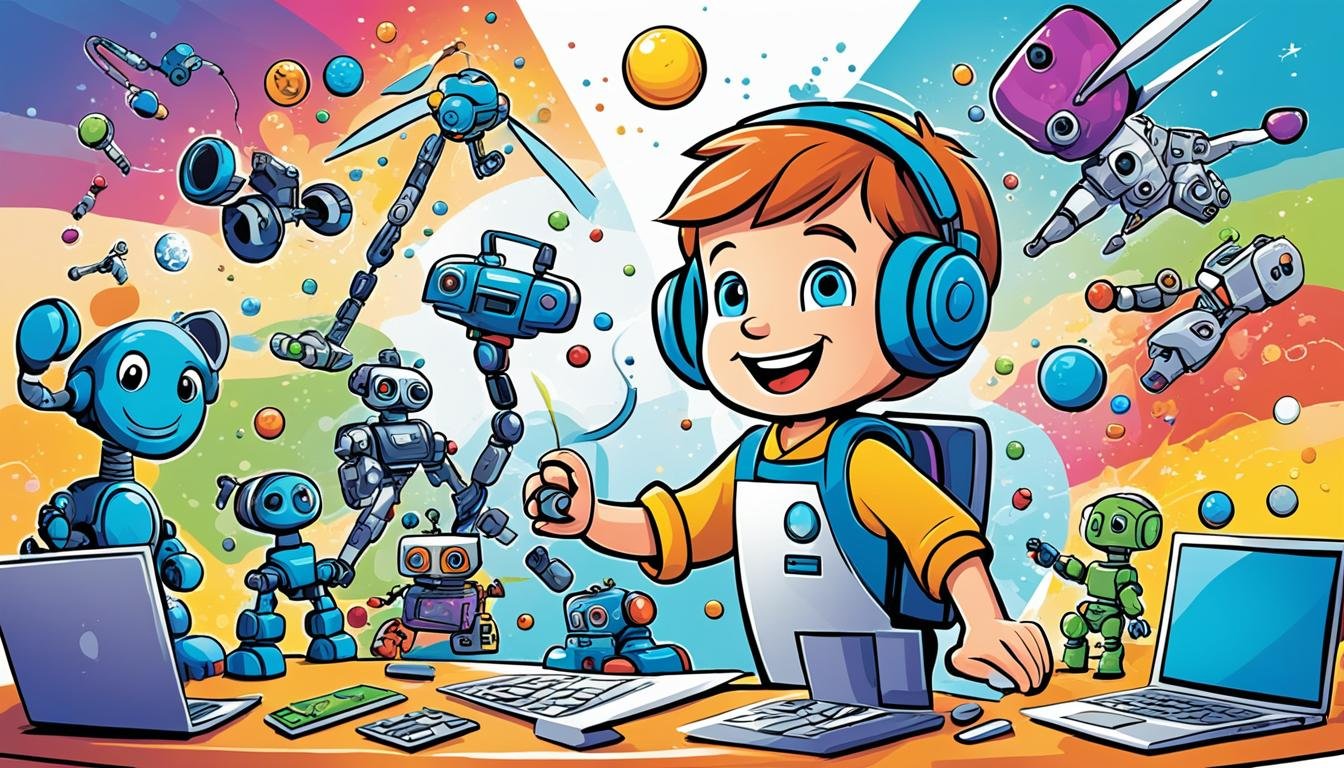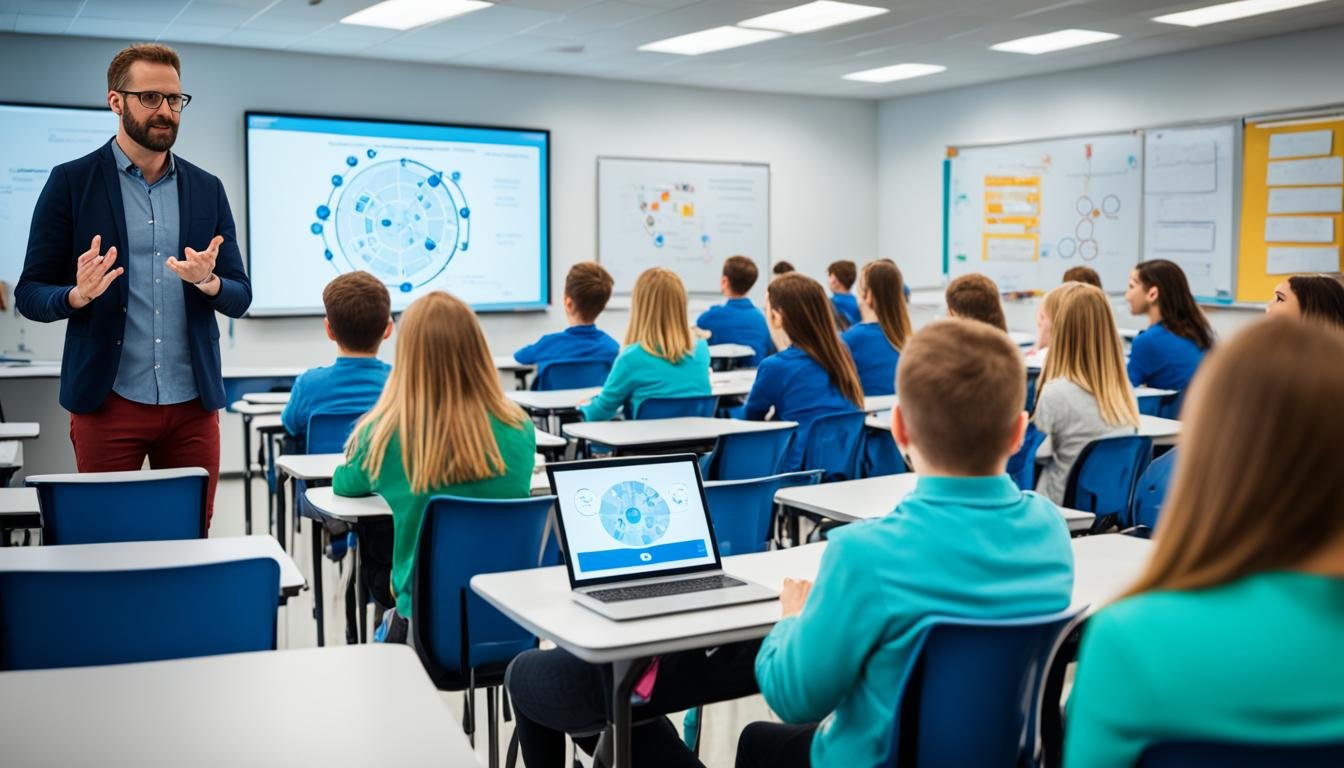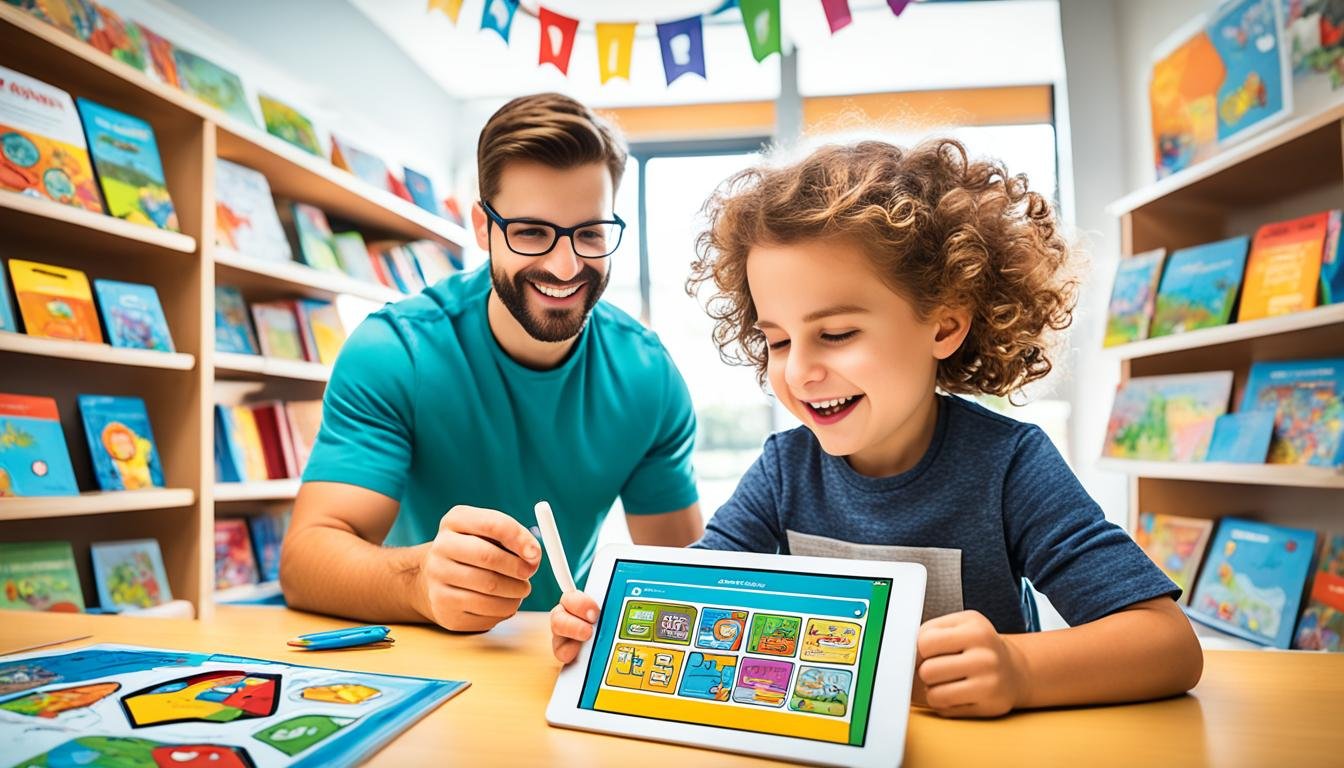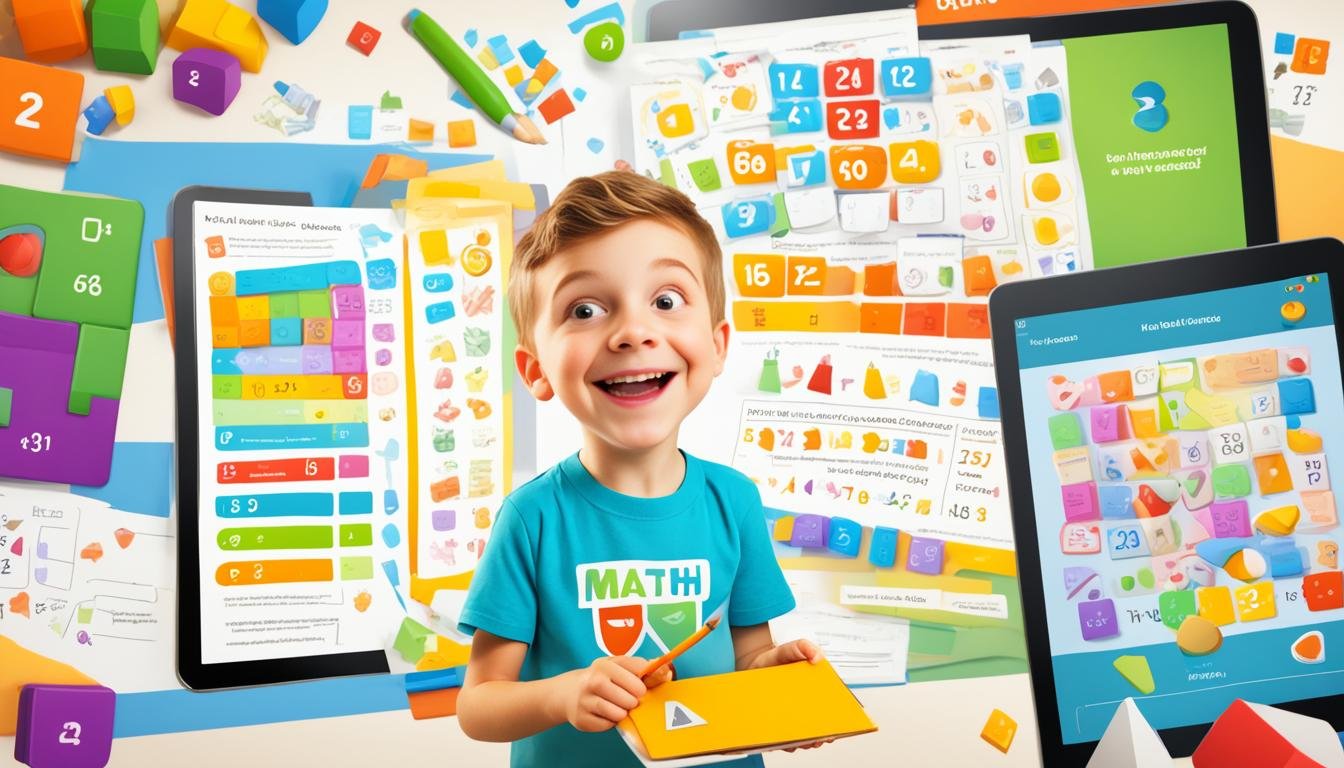How Can Parents Ensure Healthy Screen Time for Their Kids Without Hindering Learning?
As a parent, you might wonder: “Is my child’s screen time helping their learning or hurting it?” This question shows the challenge of finding a balance between tech use and your child’s growth. In our fast-changing digital world, it’s key to manage screen time well. With smart strategies, you can make sure screen time helps with learning and social skills.
Screens can be great for learning, but it’s important to set limits to prevent too much use. Studies from trusted groups like the American Academy of Pediatrics show that too much tech can harm a child’s health and growth. To help, sites like KidLinkLC.com offer learning tools for kids to do well.
Key Takeaways
- Understanding the balance between technology use and child development is critical.
- Establishing screen time limits helps in effective children’s screen time management.
- Utilizing high-quality educational content can positively impact learning.
- Monitoring screen time promotes healthy digital habits for children.
- Outdoor activities and creative hobbies serve as beneficial alternatives to screen time.
Understanding Screen Time in Today’s Digital Age
In today’s fast-changing digital world, it’s key to know how screen time affects your child. Kids use devices like smartphones, tablets, and computers every day. This use impacts their kids digital well-being and shapes their growth in many ways.
Screen time has two main uses: learning and fun. Kids can learn a lot from screens, which helps them grow smarter. But, the screen time impact on child development worries many. Studies show kids spend hours on screens, missing out on outdoor fun and family time.
Too much screen time can throw off the kids and technology balance needed for healthy growth. Parents should encourage smart screen use and activities without screens. Knowing how screens affect kids can help your family deal with today’s tech challenges.
Setting rules and talking about digital habits is crucial. For more tips on managing tech in kids’ lives, check out your resources and the terms of use for online content. This ensures kids stay safe online.
| Device Type | Average Daily Usage (Hours) | Purpose | Potential Impact |
|---|---|---|---|
| Smartphones | 3 | Communication, Gaming | Reduced physical activity, social isolation |
| Tablets | 2.5 | Education, Media | Enhanced learning, dependency on screens |
| Computers | 3.5 | Homework, Gaming | Improved skills, potential addiction |
Health Concerns Associated with Excessive Screen Time
Technology is a big part of our lives now. It’s crucial to know how too much screen time affects our health. One big worry is getting obese because we sit too much from staring at screens. Kids often skip being active when they’re on screens for hours, which is bad for their health.
Obesity Risks and Screen Time
Studies show a strong link between being overweight and too much screen time. Kids who watch screens a lot tend to move less and play less. This can make their BMI go up. Obesity is caused by many things, including:
- Increased calorie intake: Kids might eat more snacks while watching TV or playing games.
- Reduced physical activity: Being on screens means doing less exercise or playing outside.
- Unhealthy food habits: Kids might prefer fast food and sugary snacks during screen time.
Link to Sleep Disturbances
Too much screen time also hurts sleep quality. Studies show it can lead to sleep problems. The blue light from devices can stop melatonin production, which helps us sleep. Important points include:
- Poor sleep duration: Kids might have trouble falling asleep because they’re too caught up in games or videos.
- Irregular sleep patterns: Using screens before bed can mess up their sleep schedule.
- Decreased sleep quality: Having screens in the bedroom can make sleep broken and leave them tired.

Knowing these health risks shows why we need to watch how much screen time kids have. We should encourage them to have healthier habits. Cutting down on screen time can really help their physical and mental health.
Positive and Negative Effects of Screen Time on Learning
Screen time is now a big part of kids’ lives. It brings both good and bad sides to their learning. With the right way to use it, you can make screen time help with learning. It’s key to know how to use screen time well to help your child do well in school.
Educational Benefits of Screen Time
When used right, screen time can be a great learning tool. High-quality educational content can make learning fun and interactive. This can boost reading, thinking, and solving problems skills. Studies show that using technology in a planned way can really help with learning.
By taking part in educational activities, kids can get ready for the future. They can learn important skills that will help them later on.
Challenges to Academic Performance
But, too much or just sitting there screen time can hurt learning. It can replace important study time, making kids less interested in learning. Parents need to watch out to keep a good balance.
If they don’t, it could hurt how well kids do in school. For tips on managing screen time, check out studies like those at JAMA Pediatrics.
Healthy Screen Time for Kids: Guidelines by Age
Managing screen time for kids means knowing the screen time guidelines for children from health experts. These guidelines suggest balancing screen time with other important activities. Parents should set screen time limits that fit their child’s age and needs.
Recommendations for Birth to 18 Months
For kids under 18 months, it’s important to limit screen time. Most screen time should be live video chats to help them connect with others. Parents should watch over their kids to make sure they use screens safely and meaningfully. This is part of child screen time recommendations that help kids grow and learn without too much passive watching.
Screen Time Limits for Preschoolers
When kids are in preschool (2 to 5 years old), they should watch screens for only one hour a day. The content should be high-quality and help with learning and interaction. Parents need to check what their kids watch and make sure they’re not just sitting there. These rules help kids have enough time to play and be with others while still using screens wisely.

Following these guidelines helps kids use screens in a healthy way during their early years. For more info, check out the full guidelines from pediatric experts.
| Age Group | Recommended Screen Time | Content Type |
|---|---|---|
| Birth to 18 Months | Limited to live video chats | Parental supervision required |
| 18 to 24 Months | Limited, under supervision | High-quality educational programming |
| 2 to 5 Years | One hour per day | High-quality educational content |
Encouraging Active Engagement with Technology
Using technology in a smart way can make learning fun for kids. Choose educational content that grabs their attention and boosts thinking skills. It’s key to make sure technology helps kids grow and learn.
High-Quality Educational Content
Look for apps and programs that make learning fun. Interactive videos and tutorials are great for sparking curiosity. Content that makes kids think and explore helps them solve problems. Choosing quality content means tech is a good part of learning.
Interactive Games to Boost Learning
Games can make learning exciting. They get kids to take part and learn in new ways. Games like Osmo or Kahoot! turn screen time into something useful. They make learning subjects like math or science fun. This kind of tech use helps kids learn and remember better.
| Interactive Game | Focus Area | Age Group | Benefits |
|---|---|---|---|
| Osmo | STEM | 4-12 years | Enhances creativity and problem-solving |
| Kahoot! | General Knowledge | 8+ years | Promotes teamwork and healthy competition |
| Duolingo | Language Learning | 6+ years | Encourages daily practice and language retention |
| Simplilearn | Professional Skills | 12+ years | Offers practical skill-building courses |
By picking great educational content and games, you make a space where kids learn and have fun with screens.
Setting Boundaries for Kids’ Screen Time
It’s important to set limits on how much screen time your kids have. This helps keep a good balance in their life. By doing this, kids can do other activities that are good for their growth. Setting rules for screen time also helps manage their tech use and promotes healthier habits.
Creating Tech-Free Zones
Designating tech-free areas at home is a great way to manage kids screen time. For example, the dining room can be tech-free during meals, and bedrooms at night. These areas encourage kids to do other things. They help create a space for more interaction and better family talks.
Implementing Consistent Screen Time Rules
Clear rules are key to managing screen time rules well. Being consistent teaches kids the value of tech use and time limits. You might plan a daily schedule for screen time. Explaining why these limits are important can help your kids follow them better. For more tips on a balanced approach, check out these technology usage recommendations from experts.
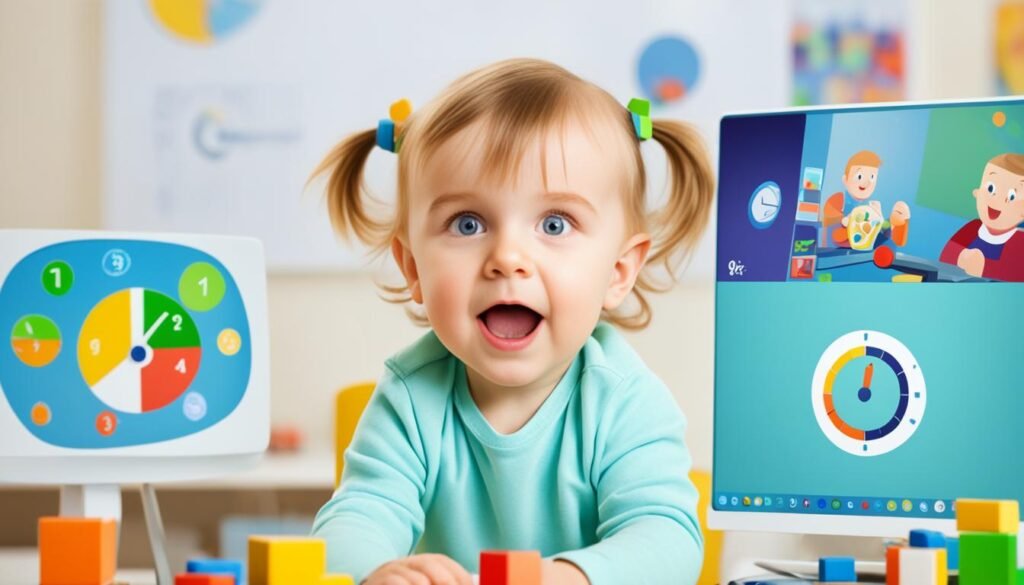
Promoting Alternative Activities to Screen Time
It’s important to get your kids to do things other than screen time. This helps them stay healthy and grow well. By encouraging them to try new things, you open doors to learning and creativity that screens can’t match.
The Value of Outdoor Play
Playing outside is key in today’s digital world. It lets kids learn by exploring and helps them make friends and stay healthy. Being outside helps them see the world, work together, and get rid of extra energy. This can make them use screens less and live healthier.
Encouraging Creative Hobbies
Getting kids into creative activities is a great way to keep them away from screens. Things like drawing, painting, or making crafts boost their imagination and how they express themselves. These hobbies also improve their fine motor skills and confidence. You can start these projects at home and help them love making things.
To control screen time, add these activities to your child’s daily life. This helps their body, mind, and overall growth. For more tips on screen-free activities, check out this resource.
| Activity Type | Benefits |
|---|---|
| Outdoor Play | Enhances physical fitness, social skills, and cognitive growth. |
| Arts and Crafts | Develops creativity, fine motor skills, and boosts self-esteem. |
| Sports | Improves teamwork, discipline, and physical health. |
| Reading | Fosters imagination, enhances vocabulary, and encourages empathy. |
Impact of Screen Time on Social Skills Development
Screen time affects how well kids connect with others today. Too much screen time can make it hard for your child to talk and understand people in real life. It’s important to focus on activities that help them talk face-to-face. This is key for their social growth.
Facilitating Face-to-Face Interactions
It’s crucial for kids to talk to people in person to learn social skills. Things like family dinners, playdates, and team sports are great for this. They let kids work on talking, feeling for others, and controlling their feelings.
But, spending too much time on screens can stop this learning. It’s important to make time for real-life talks and activities.
Nurturing Emotional Intelligence
Teaching kids to understand and manage their feelings is key. Being with others helps them see and react to emotions. To help, set aside time for activities that teach emotional awareness.
Reading together, talking about feelings, and planning outings are good ways to do this. These activities help kids grow emotionally.

Less screen time and more people time helps your child grow. It makes them better at talking and dealing with social situations. Mix digital wellness with daily life to help them develop important skills.
For more on managing data and online safety, check out the policies on user data. Knowing how your child uses the internet helps them stay safe online and develop good habits.
| Social Skill | Importance | Methods to Promote |
|---|---|---|
| Communication | Essential for expressing thoughts and feelings | Storytelling, structured group games |
| Empathy | Helps in understanding others’ emotions | Role-playing, discussing various scenarios |
| Emotional Regulation | Critical for managing feelings | Mindfulness activities, emotion-based conversations |
Guidelines for Parents on Managing Screen Time
Managing screen time for kids needs a careful plan. Parents play a big role in how their kids view technology. By showing good screen habits and doing other activities, you teach them a healthy view of devices. Also, using tools to monitor screen time helps set limits and check what they watch.
Leading by Example
Your actions show your kids what’s right. Using screens wisely makes them want to do the same. Spend time off screens to build a strong family connection and enjoy the outdoors. Talk about your screen time with your kids to show why it’s important in family talks.
Utilizing Screen Time Monitoring Tools
Parental controls for screen time can really help. Apps and software give you a peek into how much your child uses screens and what they watch. They let you:
- Set daily or weekly time limits
- Monitor what they watch
- Talk about what they see
This way, you’re not just controlling screen time but also teaching your kids about digital literacy.
| Strategy | Description | Benefits |
|---|---|---|
| Model Behavior | Demonstrate balanced screen use | Encourages children to mimic healthy habits |
| Set Limits | Use monitoring tools to set time restrictions | Helps manage overall screen time |
| Engagement | Discuss and share screen content with kids | Promotes critical thinking about media |
Benefits of Reducing Screen Time
Reducing screen time has many benefits for your child’s growth and happiness. It helps balance digital and physical activities. This makes a better environment for kids.
Enhanced Physical Activity and Well-Being
Getting kids to move more is key for their health. With less screen time, they’ll likely play outside, join sports, or exercise. This helps their health and teaches them social skills.
Studies show less screen time means better heart health and fewer obesity cases in kids.
Improved Attention and Focus
Less screen time means kids can pay attention better. They won’t be distracted by devices, so they can focus on schoolwork or hobbies. This leads to better grades and thinking skills.
Doing things without screens helps kids be more creative and solve problems better.

So, cutting down on screen time is good for kids. It leads to healthier habits and better focus. This makes childhood more rewarding.
Understanding the Importance of Digital Literacy
In today’s digital world, teaching digital literacy for children is key. It means giving your kids the skills to use the internet safely and wisely. It’s important to teach them to think critically, so they can tell real news from fake news.
Teaching Kids Critical Thinking Skills
Teaching kids critical thinking is a big part of healthy tech use. Talk to your kids about what they see online, like ads and social media. This helps them spot biases and make their own choices.
Having open talks about online content helps them think deeply. It makes them better at analyzing things and being smart digital users.

Using screen time management strategies helps too. Make sure they balance screen time with thinking and doing activities. Ask them to check where their online info comes from. This helps them learn and use the internet for learning.
Looking at digital media use reports can guide you. These tips help teach your kids to use tech wisely and understand its effects. By doing this, you’re raising a generation that knows how to handle technology well.
Strategies for Effectively Limiting Screen Time
Managing your child’s screen time is tough but key for their health. Using screen time management strategies helps balance tech use and aids in their growth. Begin by setting clear screen time rules, making your family’s routine predictable.
Encourage outdoor play and creative hobbies to cut down on screen time. Set aside hours each day without tech, letting kids enjoy painting, reading, or sports. These activities help them focus and be creative, moving them away from screens.
Offering rewards for unplugged play can motivate your kids. This shows them the worth of activities not involving screens. Talking about kids screen time guidelines helps them understand the reasons behind the limits, making them more willing to follow them.

Let your kids help set their own screen time limits. This makes them feel in charge and more likely to stick to the rules. The aim is to teach them healthy screen habits they’ll keep as adults.
Healthy Technology Use for Children: Best Practices
It’s key to promote healthy tech habits for kids. Parents can pick the right apps and shows for their kids. This helps kids learn and grow responsibly.
Talking about online activities helps kids deal with what they see online. This chat helps kids make good tech choices. It also teaches them about safe online habits. Having family talks about tech helps everyone stay connected and informed.

Doing tech activities together is a great way to bond. It lets you help your kids choose good content. Setting rules for screen time teaches kids to use tech wisely. This helps them value technology in a healthy way.
- Set specific screen time limits based on age and content.
- Encourage participation in other activities such as reading or outdoor play.
- Foster positive discussions about technology and its uses.
By using these tips, tech can be a positive part of your child’s life. These methods help kids use the internet safely and wisely.
Conclusion
Setting healthy screen time for kids is key to helping them learn and grow. It also helps avoid bad effects from too much screen time. As parents, you can guide your kids to use screens wisely in today’s digital world. By focusing on digital wellness for kids, you make sure tech helps their learning, not hinders it.
Talking openly with your kids about their screen use builds trust and understanding. When you teach them good digital habits, show them how too much screen time affects their growth. This way, tech becomes a tool for discovery, not distraction.
To make screen time positive for your child, you need to guide them carefully and be involved. By doing this, you help create a digital space that supports their growth in our tech-filled world.



